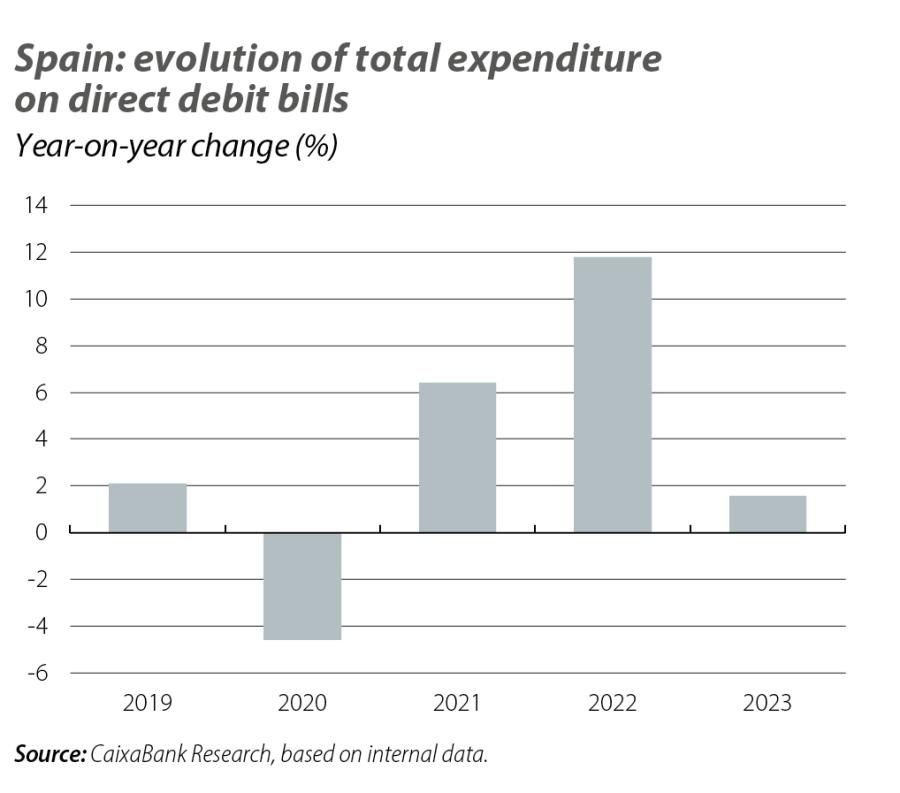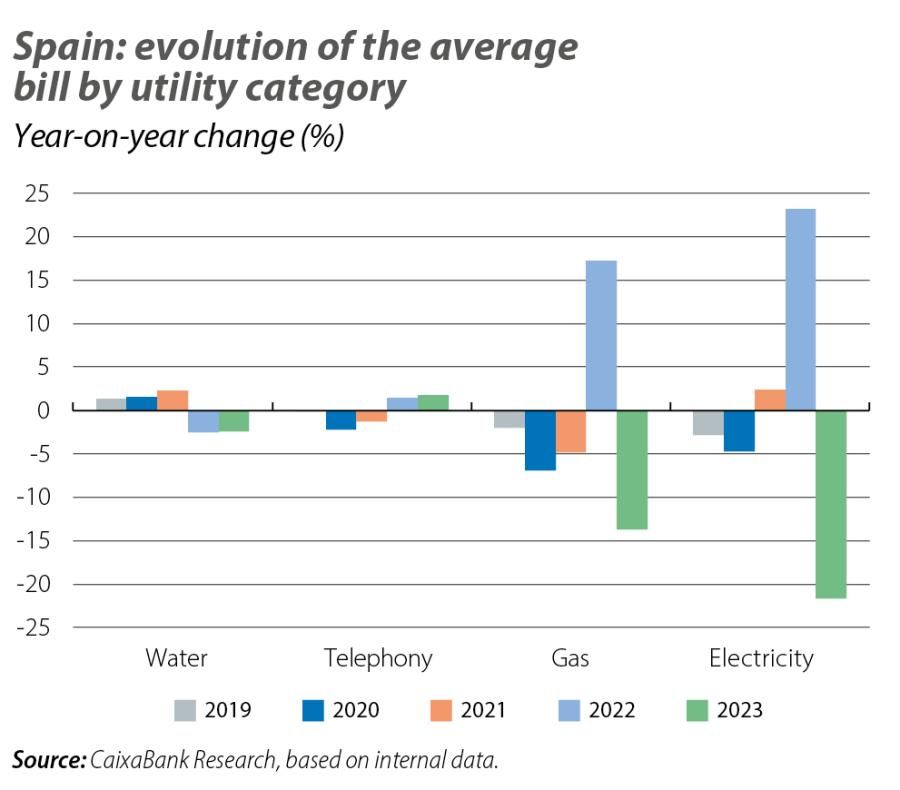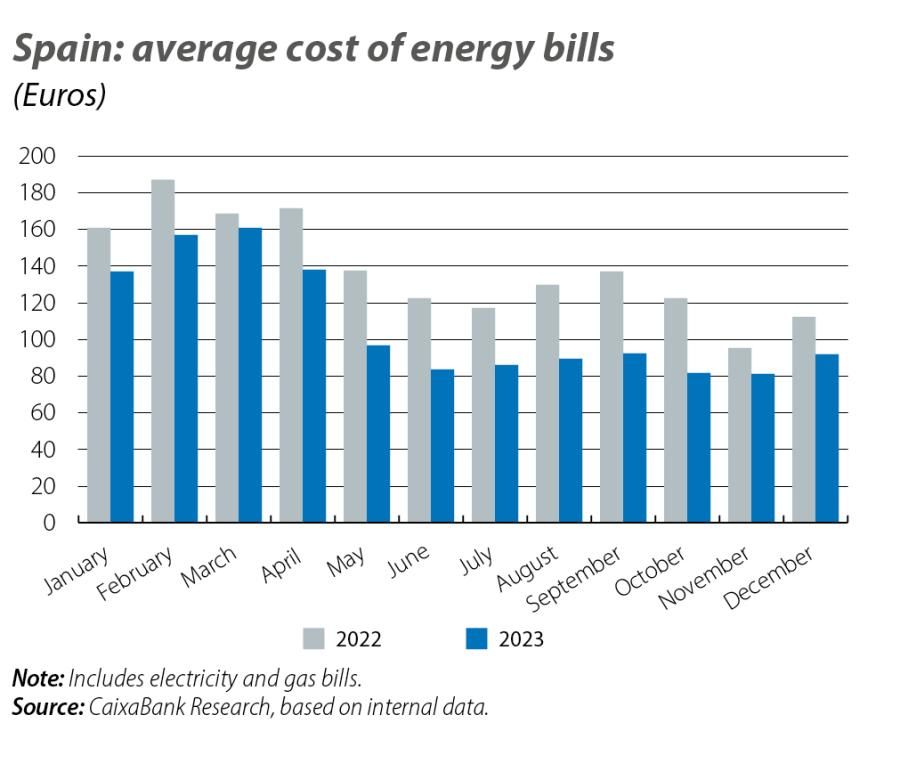Spanish household spending on bills in 2023, a respite after a gruelling 2022
How has spending on water, electricity and gas bills evolved over the past five years? We analyse anonymised information on direct debit payments made from CaixaBank accounts, including the key component of utilities, to understand how much effort Spanish households have had to make in paying their energy bills.

The recent inflation surge has hit households hard since the end of the pandemic, although during the course of 2023 it moderated and ended the year at more manageable levels. In December, specifically, it stood at 3.1%. This moderation has largely been due to the considerable decline in energy prices. For instance, the electricity component of the CPI fell by 36.8% in the year as a whole.1 But how has household expenditure evolved in terms of essential items, such as utilities?
- 1. For more details on the energy component’s contribution to inflation, see the Focus «The importance of intermediate costs in inflation dynamics in Spain» in the MR01/2024.
At CaixaBank Research we analyse card spending and cash withdrawals on a weekly basis in our Consumption Tracker and on a monthly basis in our Real-Time Economics portal. We have also examined how the impact of the energy crisis in 2022 was translated to household electricity and gas bills.2 In this article, we will explore what has happened to total household expenditure on direct debit bills, with a particular focus on the key component of utilities (water, electricity, gas and telephony).3 To this end, we will analyse fully anonymised information on direct debit payments made from CaixaBank accounts, as one of the main payment channels used by households.4
The evolution of expenditure by direct debit over the last five years has been driven by the pandemic and the subsequent energy crisis. The restrictions imposed due to COVID-19 impacted Spaniards’ consumption and this was reflected in a 4% reduction in total direct debit expenditure in 2020. This pause was followed by two years of sharp increases: expenditure on direct debit bills grew by 6.4% in 2021 and by 11.8% in 2022. By comparison, the headline CPI stood at 3.1% in 2021 and at 8.4% in 2022. That is, the amount spent on bills increased some 3 pps more than the cost of living. In 2023, the situation has changed: expenditure by direct debit grew by 1.5% this past year, 2 pps below the year’s average inflation.
- 2. See, for example, the Focuses «The evolution of Spanish households’ electricity bills in 2022» in the MR12/2022 and «Electricity prices are sky high, but what about household bills?» in the MR01/2022.
- 3. The breakdown of direct debit expenditure reveals that it corresponds mostly to utilities (27%), insurance (21%) and rents (15%).
- 4. Direct debit expenditure accounts for 20% of the total 2023 expenditure carried out by card, cash withdrawals and direct debit payments, according to internal data.

In the case of utility bills (water, electricity, gas and telephony), where consumers have less room for adjustment in the event of a crisis, we see marked differences (see second chart). In water and telephony, the expenditure was quite similar throughout the period analysed. The average water bill in 2023 was 2% lower than in 2022, while in the case of telephone bills it was 1% higher. In contrast, expenditure on energy has been much more volatile. The average electricity bill rose 23% in 2022 but fell 21% in 2023, meaning that household bills in 2023 were 6% lower than in 2019. Similarly, gas bills increased 17% in 2022, but fell 13% in 2023, and ended up being 10% lower than in 2019. Since the changes in gas and electricity prices between 2019 and 2023 have been smaller than this, these reductions essentially reflect households’ efforts to reduce their energy consumption.

Analysing the cost of energy bills month by month, we see that in all months of 2023 they were lower than in 2022 (around 30 euros on average), and especially between May and October (when they were 31% lower). Thus, households spent an average of 108 euros on electricity and gas in 2023, down from 138 euros in 2022 (and 115 euros in 2019). For 2024, the gradual withdrawal of the various anti-inflation measures planned throughout the year can be expected to have some impact on energy bills. Here at CaixaBank Research we will continue to monitor the situation in real time.






